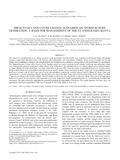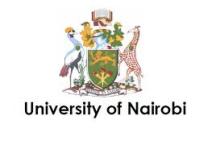Resource information
The effects of conceptual land cover change scenarios on the generation of storm runoffs were evaluated in the Nyando Basin. The spatial scenarios represented alternatives that vary between full deforestation and reforestation. Synthetic storm events of depths 40, 60 and 80mm were formulated according to the rainfall patterns and assumed to have durations corresponding to the runoff times of concentration.
The Natural Resource Conservation Service–Curve Number model was used to generate runoff volumes within the sub-catchments, which were subsequently routed downstream to obtain effects in the whole basin. The simulated land cover change impacts were evaluated relative to values obtained from the actual land cover state of the basin in the year2000. From the results, an agricultural land cover scenario consti-
tuting of about 86percent of agriculture indicated increased runoff volumes in the entire basin by about 12percent. An agricultural-forested land cover scenario with 40 and 51percent of forest and agriculture respectively revealed reduced runoff volumes by about 12percent.
Alternatively, a scenario depicting a largely forested land cover state with about 78percent of forests reduced the runoff volumes by about 25percent according to the model estimates. Runoff volumes in the basin were also likely to reduce by about 15percent if the appropriate land cover scenario for the respective sub-catchments were to be assumed for runoff management purposes. Considering the prevalent data
uncertainty, the study effectively highlights the potential hydrological vulnerability of the basin. The results obtained can form a basis for appropriate catchment management of the area.


